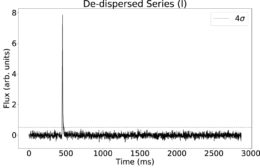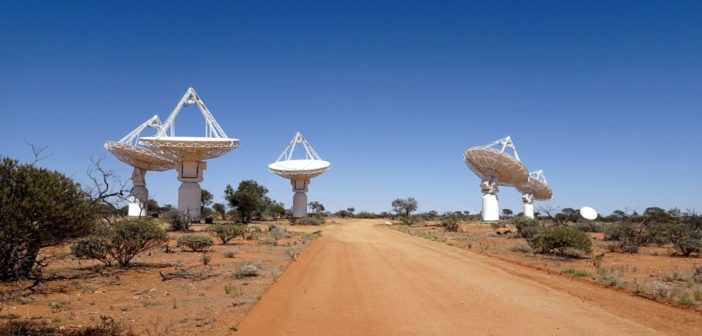As powerful millisecond bursts of radio emission continue to light up our detectors from across the universe, the hunt for the origins of these fast radio bursts continues. It’s the search for light before and after the burst, however, that might prove key to unraveling their mystery.
An Extragalactic Puzzle

Artist’s impression of the ASKAP radio telescope finding a fast radio burst. Other observatories are shown joining in follow-up observations. [CSIRO/Andrew Howells]
Many of the leading origin theories for FRBs come with predictions of other emission that should complement the radio flash. The birth of a magnetized neutron star, for instance, should produce not only an FRB, but also a radio afterglow — steadier radio emission that appears after the burst and then slowly fades over time.
The fact that we haven’t yet found any radio afterglows definitively associated with FRBs means one of three things: 1) they don’t happen, 2) they’re fainter than we can detect, or 3) they evolve on quicker timescales than we’ve been surveying, so they’ve already faded by the time we look. A new radio array enterprise is focusing on ruling out the third of these possibilities.

CRAFT is designed to be able to run simultaneously with other projects on the ASKAP radio array. [CSIRO/Alex Cherney]
Real-Time Eyes on the Skies
To catch a quickly evolving afterglow, we need real-time observations of FRBs — allowing us to monitor the source for radio emission before, during, and immediately after the burst. To this end, a new survey was begun in mid-2019 with the The Australian Square Kilometre Array Pathfinder (ASKAP): the Commensal Real-time ASKAP Fast Transients Survey (CRAFT).
CRAFT runs continuous low-time-resolution observations of the sky while ASKAP is being used for other survey science projects. When an FRB is spotted, the survey automatically saves the data from before and after the FRB itself, so that the survey team can search it for radio precursor and afterglow emission.
In a new study, a team of scientists led by Shivani Bhandari (Australia Telescope National Facility, CSIRO, Australia) reports the first detection of an FRB in this mode: FRB 191001.
The Verdict: No Glow

ASKAP de-dispersed light curve showing the ms-scale pulse of radiation from FRB 191001. [Adapted from Bhandari et al. 2020]
What does this mean? The lack of detectable afterglow for FRB 191001 alone doesn’t yet rule out any formation scenarios — but it does demonstrate that the afterglow was either fainter than our detection thresholds, or it didn’t occur at all.
And this CRAFT detection is just the start! With more observations like this one — especially of closer FRBs that would be expected to appear with correspondingly brighter afterglows — we may soon be able to narrow down the options of what causes these mysterious flashes.
Citation
“Limits on Precursor and Afterglow Radio Emission from a Fast Radio Burst in a Star-forming Galaxy,” Shivani Bhandari et al 2020 ApJL 901 L20. doi:10.3847/2041-8213/abb462

3 Comments
Pingback: From AAS NOVA: “ASKAP Finds a Real-Time Radio Burst, but No Glow” | sciencesprings
Pingback: ASKAP znajduje rozbłyski radiowe w czasie rzeczywistym – PTMA Kraków
Pingback: ASKAP znajduje rozbłyski radiowe w czasie rzeczywistym – Astronomia Śląska